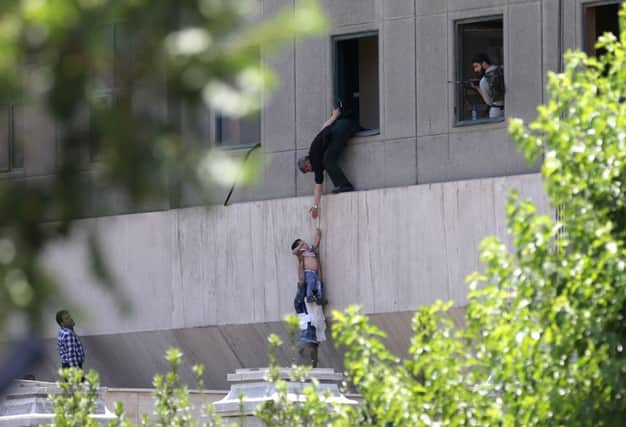Twelve dead after IS attack on Iranian parliament


Islamic State claimed it was behind the attacks, the first by the Sunni extremist group in the Shiite-ruled nation.
The attacks drew condemnation and condolence from the governments of Pakistan and from Iran’s close allies in the Russian and Syrian governments.
Advertisement
Hide AdAdvertisement
Hide AdThe assault began when assailants armed with Kalashnikov rifles and explosives stormed the parliament building in Tehran.
The hours-long siege ended with four attackers dead, at least one of whom blew himself up. In images circulating in Iranian media, gunmen were seen holding rifles near the windows of parliament. Another image showed a toddler being handed off through a first-floor window to safety outside as an armed man looked on.
The IS group’s Aamaq news agency released a 24-second video purportedly shot inside the parliament building during the siege.
As the parliament siege was unfolding, gunmen and suicide bombers attacked the shrine of Iran’s revolutionary leader, Ayatollah Ruhollah Khomeini, which is located just outside Tehran. Khomeini, who died in 1989, is a towering figure in Iran who led the 1979 Islamic revolution that toppled the Western-backed shah and became its first supreme leader.
Iranian parliament speaker Ali Larijani called the attacks a cowardly act and proof that Tehran has made an enemy of militant Islamic groups through its policies and actions in Iraq and Syria.
“Iran is an active and effective pillar in the fight against terrorists and they want to damage it,” he said.
The two attacks, which wounded dozens of people, are likely to deepen enmity and the regional battle for power between Saudi Arabia and Iran. Already, tensions are high following a cut in ties this week between four Arab countries and Qatar over accusations it supports terrorist groups and is aligning itself too closely with Iran.
Both Saudi Arabia and Iran accuse one another of policies that support extremists in the region. Saudi Arabia has long pointed to the absence of IS attacks on Iran as suggestion of Tehran’s culpability. Iran, on the other hand, has pointed to Saudi Arabia’s support for jihad throughout different times in history and its backing of hard-line Sunni rebels groups in Syria.
Advertisement
Hide AdAdvertisement
Hide AdSaudi Arabia has itself been a target of numerous lethal attacks by IS affiliates in the Arabian Peninsula, who see the kingdom’s Western-allied leadership as heretics. The group has also targeted Shiites in Saudi Arabia and Kuwait.
The group’s militants are directly at war with Iranian-backed forces in Syria and Iraq, and view Shiites as apostates.
Deputy interior minister Mohammad Hossein Zolfaghari told Iran’s state TV the apparently male attackers wore women’s attire. The semi-official Tasnim news agency later reported the siege had ended with four of the attackers killed.
Mizan Online, an Iranian state-run news website, said 12 people were killed and 42 wounded in the two attacks. It quoted Pirhossein Kolivand, the head of Iran’s emergency department.
An Associated Press reporter saw several police snipers on the rooftops of buildings around the parliament. Shops in the area were shuttered, and gunfire could be heard. Witnesses said the attackers were shooting from the fourth floor of the parliament building down at people in the streets below.
Police helicopters circled over the parliament building.
Iranian security officials have not said who they suspect is behind the attacks.